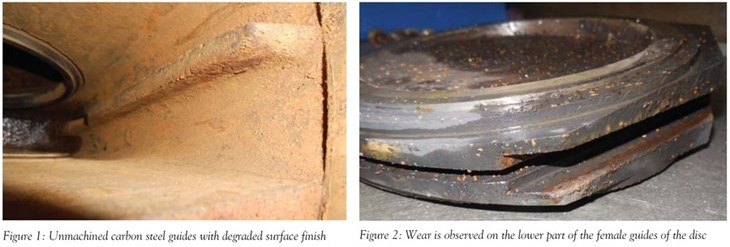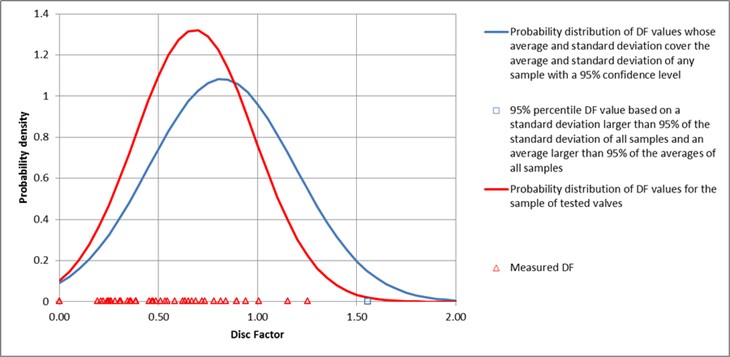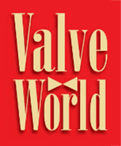The application of the Optimov® program (Ref. 1 and 2) since 2014 has demonstrated that some families of wedge gate valves require a higher torque to open or close under dynamic flow conditions than historically assumed (Ref. 3, 4 and 5). The In-Service Inspection tests performed before 2014 consisted solely in stroke time verifications performed in static flow conditions, which could not reveal such issue. The production of this kind of wedge gate valve was discontinued in the early 1980’s.
The historical calculation model assumes that the contact surfaces of the disc against the guides and the seats are both covered with stellite material. After opening of the valves for inspection, the causes of the higher torque requirements were identified as unmachined carbon steel guides with degraded surface finish (see Figures 1 and 2) and larger manufacturing tolerances of the male and female guides than expected from industry standards. The unmachined carbon steel guides result in larger friction coefficients whilst the large manufacturing tolerances result in disc tipping. The disc tipping creates a lever effect on the disc under dynamic flow conditions. This lever effect results in higher torque requirements. Significant differences of the dimensions of the discs, guides and seats between valves of identical sizes also lead to significant variations of the performances of these wedge gate valves within groups of valves of identical sizes.


Determination of a new Disc Factor
The higher than expected torques in dynamic conditions required an update of the Optimov® model for these families of wedge gate valves. The larger number of Optimov® dynamic tests obtained with active power measurements allowed for determination in 2015 of conservatively bounding Disc Factors (DF) through a statistical inference approach. This statistical approach consists in modeling the Gaussian distributions of the sample subsets to determine μ95, the percentile 95 of average DF values of the samples, and σ95, the percentile 95 of standard deviations of DF values of the samples. The percentile 95 of the Gaussian distribution (μ95, σ95) is taken as the new DF value.
This approach ensures that the new DF value bounds any measured DF with 95% confidence level probability. Dynamic tests performed in 2016 (Ref. 3) confirmed that the new DF value is indeed conservative. Moreover, each new dynamic test can feed the statistical calculations to further reduce the DF value while keeping a 95% confidence level probability in the conservatisms of the so-calculated DF value.
The solutions implemented to meet the higher than expected required torques in dynamic conditions of these wedge gate valves involved increasing the torque switch settings of the actuators (through the application of our Optimov® methodology), replacement of some components within the actuators such as the motor or the spring pack and, in some cases, replacement of the actuators. The sizing of the new actuators was based on the new DF values calculated by the statistical approach described in this article.
Other solutions, although more expensive, are possible and were not implemented so far: matter addition on the female and male guides to reduce the manufacturing tolerances, machining of the male and female guides and stellite material addition on the guides. Manufacturing discs specific to individual valves is also a possible option after measurements of the specific clearance through 3D-laser measurements or molding of the inner valve body surfaces.
1. Safety related motor operated valves – Operability follow-up and performance periodic verification – nuclear and non-nuclear application, Geoffrey Vanderstappen (Tractebel), Valve World Magazine, October 2015 Ed.
2. OPTIMOV®: a non-intrusive test program for MOVs, Interview of Geoffrey Vanderstappen (Tractebel), Valve World Magazine, January/ February 2017 Ed.
3. Tractebel internal reference: 2014 Optimov test campaign in Belgian power plants
4. Tractebel internal reference: 2015 Optimov test campaign in Belgian power plants
5. Tractebel internal reference: 2016 Optimov test campaign in Belgian power plants
The author of this article would like to acknowledge the following individuals for their contributions to the works presented in this article: Olivier Gilmont, Mechanical Engineer at Tractebel: inspections of the valves and statistical calculations; Geoffrey Vanderstappen, Mechanical Engineer at Tractebel: verification of this article; Pierre Henneaux, Energy System Planning & Economics Expert at Tractebel: guidance on the use of statistical inferences.
About the author

Mr. Alexandre Nève is a Mechanical Valve Engineer for the Supply Mechanical Equipment Department (Nuclear Entity) at Tractebel, Belgium. After working for 5 years for Westinghouse Electric Belgium in I&C and Thermo-Hydraulic Systems design, he acquired an expertise on valves and actuators while contributing as mechanical team leader to the development and application of the OPTIMOV® methodology to Belgian power plants. In his free time, he enjoys travelling, cycling, swimming and learning new languages.





